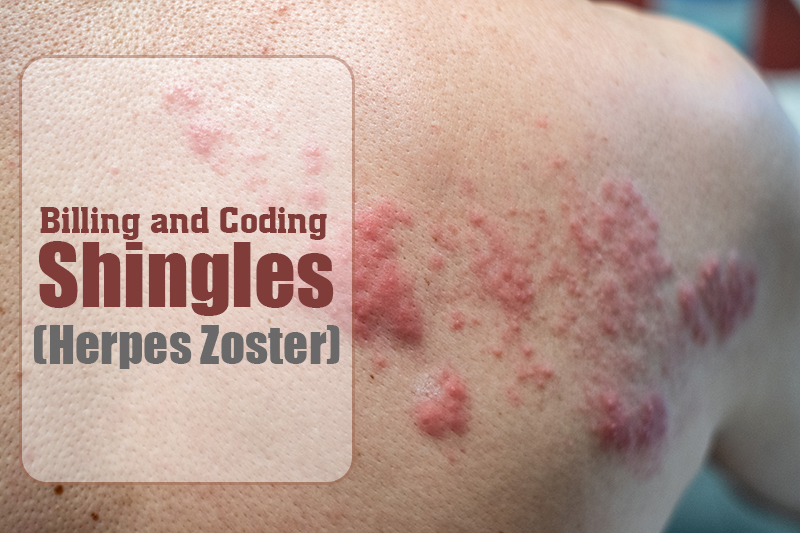Regarded as a serious viral infection, shingles (also known as herpes zoster) causes an outbreak of a painful rash or blisters on the skin. Reports from the Centres for Disease Control and Prevention (CDC) suggest that about 1 million people in the United States get shingles each year. It is estimated that about 1 out of every 3 people in the United States will develop shingles in their lifetime. Even though the condition can be painful, it is not life-threatening. Timely vaccination and other treatment modalities can reduce the risk and other complications of shingles in the long run. When it comes to medical billing and coding for skin conditions, it can be complex. Correctly reporting diagnoses such as the specificity and granularity of ICD-10 codes can be complex. Relying on the services of a professional medical billing company can ensure error-free, timely claim submission.
Causes and Symptoms
The exact factors that cause shingles is unknown. The condition can occur due to varicella-zoster virus – the same virus that causes chickenpox. Low immunity due to infections is another prominent factor that can cause shingles. The risk of this skin condition tend to be higher in old people, particularly in people above the age of 50 years who have weakened immune systems. Several additional factors such as age, cancer treatments and usage of certain medications can increase the risk of developing shingles.
Take your practice to the next level with our specialized dermatology medical billing solutions.
Shingles can appear on any part of the body. Typically, this condition appears like a single stripe of blisters that wraps around the left side or the right side of the torso. It most often appears as a band of rashes or blisters in one area of the body. Pain (which can be severe for some people) is one of the initial symptoms of shingles. Pain can occur even without developing the rash and may affect only a small section on one side of the body. Depending on the severity and location of pain, the condition can at times be mistaken for problems with the heart, lungs or kidneys. Some of the other related symptoms include –
- An itching, tingling or burning feeling in an area of the skin.
- A red rash that begins a few days after the pain
- Fatigue
- Fever and chills
- Fluid-filled blisters that break open and crust over
- Headache
- Sensitivity to light
- Sensitivity to touch
- Stomach upset
How to Diagnose and Treat Shingles
Typically, dermatologists begin the diagnosis of this condition with a detailed evaluation of the pain symptoms – including the history of pain on one side of your body, along with the rash and blisters. The nature in which the rashes tend to get distributed on the body remains an important part of the diagnosis. A tissue sample or culture of the blisters will also be taken for detailed laboratory analysis. There is no specific cure for shingles, but early treatments can help better manage the symptoms. Early treatment with prescription antiviral drugs like – Acyclovir (Zovirax), Famciclovir and Valacyclovir (Valtrex) may help speed up the healing process and reduce risk of further complications. As shingles can cause severe pain, the health care provider may also prescribe anticonvulsants, antidepressants, numbing agents such as lidocaine, in the form of a cream, gel, spray or skin patch and corticosteroid injections. If left untreated, the condition could increase the risk of several complications such as severe skin infections, vision loss and other neurological problems. Typically, shingles may last between a period of 2 and 6 weeks. Most people get shingles only once. However, in certain other cases, a person may develop shingles two or more times.
ICD-10 Codes to Report Shingles
Dermatology medical coding can be complex. Dermatologists or other specialists diagnosing and treating patients suffering from shingles are reimbursed for their services. ICD-10 codes used to indicate a diagnosis of shingles include –
- B02 Zoster [herpes zoster]
- B02.0 Zoster encephalitis
- B02.1 Zoster meningitis
- B02.2 Zoster with other nervous system involvement
- B02.21 Postherpetic geniculate ganglionitis
- B02.22 Postherpetic trigeminal neuralgia
- B02.23 Postherpetic polyneuropathy
- B02.24 Postherpetic myelitis
- B02.29 Other postherpetic nervous system involvement
- B02.3 Zoster ocular disease
- B02.30 … … unspecified
- B02.31 Zoster conjunctivitis
- B02.32 Zoster iridocyclitis
- B02.33 Zoster keratitis
- B02.34 Zoster scleritis
- B02.39 Other herpes zoster eye disease
- B02.7 Disseminated zoster
- B02.8 Zoster with other complications
- B02.9 Zoster without complications
Billing and coding for shingles (also known as herpes zoster) can be complex, as you need to know the specific codes associated with the condition. By outsourcing these tasks to professional medical billing companies that offer the services of AAPC-certified coding specialists, healthcare practices can ensure correct and timely claim submission for optimal reimbursement.
Stay compliant and avoid penalties with Outsource Strategies International’s (OSI’s) comprehensive medical coding services.






